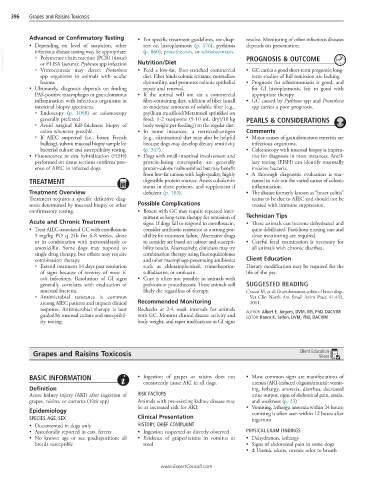Page 830 - Cote clinical veterinary advisor dogs and cats 4th
P. 830
396 Grapes and Raisins Toxicosis
Advanced or Confirmatory Testing • For specific treatment guidelines, see chap- resolve. Monitoring of other infectious diseases
• Depending on level of suspicion, other ters on histoplasmosis (p. 476), pythiosis depends on presentation.
VetBooks.ir ○ Polymerase chain reaction (PCR) (tissue) Nutrition/Diet PROGNOSIS & OUTCOME
infectious disease testing may be appropriate:
(p. 860), protothecosis, or schistosomiasis.
or ELISA (serum): Pythium spp infection
○ Vitreocentesis may detect Prototheca
term studies of full remission are lacking.
diet. Fiber binds colonic irritants, normalizes
spp organisms in animals with ocular • Feed a low-fat, fiber-enriched commercial • GC carries a good short-term prognosis; long-
lesions. dysmotility, and promotes colonic epithelial • Prognosis for schistosomiasis is good, and
• Ultimately, diagnosis depends on finding repair and renewal. for GI histoplasmosis, fair to good with
PAS-positive macrophages or granulomatous • If the animal will not eat a commercial appropriate therapy.
inflammation with infectious organisms in fiber-containing diet, addition of fiber (small • GC caused by Pythium spp and Prototheca
intestinal biopsy specimens. to moderate amounts of soluble fiber [e.g., spp carries a poor prognosis.
○ Endoscopy (p. 1098) or colonoscopy psyllium mucilloid/Metamucil sprinkled on
generally preferred food: 1-2 teaspoons (5-10 mL dry)/10 kg PEARLS & CONSIDERATIONS
○ Avoid surgical full-thickness biopsy of body weight per feeding]) to the regular diet.
colon whenever possible. • In some instances, a restricted-antigen Comments
○ If AIEC suspected (i.e., boxer, French (e.g., elimination) diet may also be helpful • Major causes of granulomatous enteritis are
bulldog), submit mucosal biopsy sample for because dogs may develop dietary sensitivity infectious organisms.
bacterial culture and susceptibility testing. (p. 347). • Colonoscopy with mucosal biopsy is impera-
• Fluorescence in situ hybridization (FISH) • Dogs with small-intestinal involvement and tive for diagnosis in most instances. Ancil-
performed on tissue sections confirms pres- protein-losing enteropathy are generally lary testing (FISH) can identify mucosally
ence of AIEC in infected dogs. protein-calorie malnourished but may benefit invasive bacteria.
from low-fat rations with high-quality, highly • A thorough diagnostic evaluation is war-
TREATMENT digestible protein sources. Assess cobalamin ranted to rule out the varied causes of colonic
status in these patients, and supplement if inflammation.
Treatment Overview deficient (p. 183). • The disease formerly known as “boxer colitis”
Treatment requires a specific definitive diag- seems to be due to AIEC and should not be
nosis determined by mucosal biopsy or other Possible Complications treated with immune suppression.
confirmatory testing. • Boxers with GC may require repeated inter-
mittent or long-term therapy for remission of Technician Tips
Acute and Chronic Treatment signs. If dogs fail to respond to enrofloxacin, • These animals can become dehydrated and
• Treat AIEC-associated GC with enrofloxacin consider antibiotic resistance as a strong pos- quite debilitated. Fastidious nursing care and
5 mg/kg PO q 24h for 6-8 weeks, alone sibility for treatment failure. Alternative drugs close monitoring are required.
or in combination with metronidazole or to consider are based on culture and suscepti- • Careful fecal examination is necessary for
amoxicillin. Some dogs may respond to bility results. Alternatively, clinicians may try all animals with chronic diarrhea.
single drug therapy, but others may require combination therapy using fluoroquinolones
combination therapy. and other macrophage-penetrating antibiotics Client Education
○ Extend treatment 14 days past resolution such as chloramphenicol, trimethoprim- Dietary modification may be required for the
of signs because of severity of most E. sulfadiazine, or amikacin. life of the pet.
coli infections. Resolution of GI signs • Cure is often not possible in animals with
generally correlates with eradication of pythiosis or protothecosis. These animals will SUGGESTED READING
mucosal bacteria. likely die regardless of therapy. Craven M, et al: Granulomatous colitis of boxer dogs.
○ Antimicrobial resistance is common Vet Clin North Am Small Anim Pract 41:433,
among AIEC patients and impacts clinical Recommended Monitoring 2011.
response. Antimicrobial therapy is best Rechecks at 2-4 week intervals for animals AUTHOR: Albert E. Jergens, DVM, MS, PhD, DACVIM
guided by mucosal culture and susceptibil- with GC. Monitor clinical disease activity and EDITOR: Rance K. Sellon, DVM, PhD, DACVIM
ity testing. body weight, and taper medications as GI signs
Grapes and Raisins Toxicosis Client Education
Sheet
BASIC INFORMATION • Ingestion of grapes or raisins does not • Most common signs are manifestations of
consistently cause AKI in all dogs. uremia (AKI-induced oliguria/anuria): vomit-
Definition ing, lethargy, anorexia, diarrhea, decreased
Acute kidney injury (AKI) after ingestion of RISK FACTORS urine output, signs of abdominal pain, ataxia,
grapes, raisins, or currants (Vitis spp) Animals with pre-existing kidney disease may and weakness (p. 23)
be at increased risk for AKI. • Vomiting, lethargy, anorexia within 24 hours;
Epidemiology vomiting is often seen within 12 hours after
SPECIES, AGE, SEX Clinical Presentation ingestion
• Documented in dogs only HISTORY, CHIEF COMPLAINT
• Anecdotally reported in cats, ferrets • Ingestion suspected or directly observed PHYSICAL EXAM FINDINGS
• No known age or sex predisposition; all • Evidence of grapes/raisins in vomitus or • Dehydration, lethargy
breeds susceptible stool • Signs of abdominal pain in some dogs
• ± Uremic ulcers, uremic odor to breath
www.ExpertConsult.com

